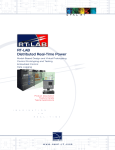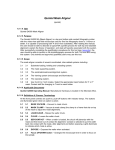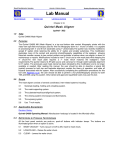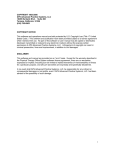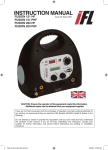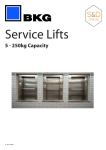Download 1.7 Example 6: Simple design exercise for a hydraulic suspension
Transcript
Chapter 1 Tutorial examples 1.7 Example 6: Simple design exercise for a hydraulic suspension Objectives: Do a simple initial design study for a hydraulic suspension using: • Analytical analysis. • AMESim standard runs. • Batch runs. • Linear analysis. The system is shown in Figure 1.38. The hydraulic jack with the two orifices is the damper and the accumulator is the spring. It is proposed to use this suspension on the cab of a truck. The load on each suspension strut is 250kg. Figure 1.38: A simplified hydraulic suspension. Step 1: Build the system and run a simulation 1. Build the system using Premier submodel. Much sizing can be done by simple calculations but simulation can be a great help in rapidly confirming the calculations and adding dynamics to the steady state values. The two ports of the jack are interconnected and in equilibrium. The pressures above and below the jack piston will be the same. Using a force balance in the equilibrium position in terms of the piston area Apist and rod area Arod PA pist ∠ P ( Apist ∠ A rod ) = 250xg It follows that 32 PA rod = 250g Hydraulic Library 4.2 User Manual From this if we want an operating pressure of about 70 bar the diameter of the rod must be about 22.3 mm. We will use a rod diameter of 20 mm and a piston diameter of 40 mm. 2. Set the parameters of the following table. Submodel HJ000 Parameter title Value rod displacement [m] 0.15 piston diameter [mm] 40 diameter of rod [mm] 20 angle rod makes with horizontal [degree] 90 total mass being moved 250 3. Run a dynamic simulation for 10 s. Figure 1.39: Pressure and displacement plots. Figure 1.39 shows the system pressure and the displacement. Problem 1: The starting values are poor. 33 Chapter 1 Tutorial examples Problem 2: The accumulator spring with its precharge pressure of 100 bar is taking no part in this simulation. The only spring involved at the moment is the hydraulic fluid. Solution to problem 1: 1. In Parameter mode select Parameters u Set final values. This will give reasonable starting values for state variables. You will find that the piston has dropped slightly from the mid-position. 2. Reset the following parameters: Submodel Parameter title rod displacement [m] Value 0.15 HJ000 rod velocity [m/s] 0 3. Run a simulation again and check that the system is in equilibrium with the rod in mid-position. Solution to problem 2: The two parameters we can vary are the precharge pressure and volume of the accumulator. For the accumulator to work as a spring, the precharge pressure must be lower than the equilibrium pressure. The volume of fluid in the jack varies according to the piston position. This is due to the rod. The difference between the minimum and maximum oil volume is A rod x stroke which is 0.1 L. The accumulator volume should be a bit bigger than this but certainly not 10 L. Step 1: Investigate the spring rate 1. Set the following values Submodel Parameter title Value gas precharge pressure [bar] 10 accumulator volume [L] 0.5 HA001 1. Do a run and verify that these values do not disturb the equilibrium. The values should have changed the spring rate but not the equilibrium position. We need now to investigate the spring rate. 34 Hydraulic Library 4.2 User Manual 2. Set the following values Submodel Parameter title Value output at start of stage 1 [null] 0 output at end of stage 1 [null] 2500 duration of stage 1 [s] 40 UDOO output at start of stage 2 [null] 2500 output at end of stage 2 [null] -2500 duration of stage 2 [s] 80 3. Do a run for 120 s. 4. Plot graphs of: • rod displacement (HJ000) • pressure at port 1 (HJ000) against • external force on rod (HJ000) Figure 1.40: Displacement against force. The force value of 2500 N pushes down on the suspension with a value corresponding to the weight of the car. The force of -2500 effectively takes the complete weight off the suspension. The slow evolution of the force duty cycle ensures that the system is very close to equilibrium at all times. The plot of displacement against force (Figure 1.40) shows the non-linear nature of the spring. It also shows that the suspension does not ‘bottom out’ but it does ‘top out’. 35 Chapter 1 Tutorial examples Figure 1.41: Force against pressure. Figure 1.41 shows that maximum pressure is 160 bar and the minimum is about 40 bar which occurs when the suspension tops out. We could continue by doing further analytical calculations. Alternatively we could do batch runs varying the accumulation pre-charge pressure and accumulator volume and the interested reader could try this. However, we will end the exercise by considering the damping of the suspension which is mainly provided by the two orifices. For simplicity we will assume they are of the same characteristics. Step 2: Setup a batch run varying the diameters of the orifices with the vehicle subject to a step change in force 1. Select Parameters u Global parameters. 2. Set up the global parameter shown. 3. Set the following parameters for BOTH orifices: Submodel OR000 Parameter title 1 for pressure drop/flow rate pair 2 for orifice diameter equivalent orifice diameter [mm] 36 Value 2 DIAM Hydraulic Library 4.2 User Manual 4. Set up a duty cycle to give a step increase in force: Submodel Parameter title Value output at start of stage 1 [null] 0 output at end of stage 1 [null] 0 duration of stage 1 [s] 1 UD00 output at start of stage 2 [null] 500 output at end of stage 2 [null] 500 duration of stage 2 [s] 9 5. Select Parameters u Batch parameters. 6. Drag and drop the global parameter into the Batch parameters dialog box and set the following values for a batch run: Figure 1.42: Batch parameters 7. Perform a batch run for 10 s and plot the displacement of the piston. Figure 1.43: Batch run results for rod displacement The batch run will use orifice diameters of 1 to 6 mm in steps of 0.5mm. Zooming 37 Chapter 1 Tutorial examples in on the plot it becomes clear that 3 mm gives a reasonable degree of damping. 8. Remove the step from UD000 so that there is a constant force of 0 N. 9. Insert a linearization time at 10 s. 10. Repeat the batch run and look at the damping ratio for the oscillatory frequency. Looking at the eigenvalues selecting the .jac0.1 to .jac0.11 files we see that below 2.5 mm the system is very highly damped. However, the results for the 1 mm diameter give an oscillatory frequency of about 25 Hz which is curious but could be investigated with tools such as modal shapes. For diameters of 2.5 mm and greater there is an oscillatory frequency of about 1.23 Hz and the damping ratio is as follows: Diameter of orifice [mm] Damping ratio 2.5 0.533 3 0.308 3.5 0.194 4 0.130 4.5 0.091 5 0.067 5.5 0.050 6 0.039 We can see the evolution of these eigenvalues in a root locus plot. 38 Hydraulic Library 4.2 User Manual Figure 1.44: Root locus plot. A more refined search between 2.0 and 3.0 mm would be a good idea but 2.5 mm seems reasonable. 39










